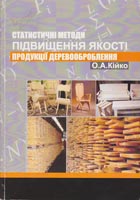SUMMARY OF DISCIPLINE
Statistical methods of quality products improving in the woodworking
Direction of educational training: Woodworking technology
Educational qualification level: Bachelor
Course content:
1. General presentation of statistical methods the product quality improving.
2. Overview of the researching methods.
3. Theoretical foundations of the statistical methods.
4. The procedures for verification of the statistical hypotheses.
5. Methods of the statistical information collecting.
6. The graphical interpretation of the statistical data.
7. The usage of the control charts in the statistical analysis.
8. General description of the "Six Sigma" concept.
9. Basics of the correlation and regression analysis.
Results of the study:
The purpose of the discipline is to develop the students' ability to apply statistical
methods to improve product quality in woodworking.
Acquired knowledge:
The graduate-bachelor should know:
• fundamentals of mathematical statistics;
• basics of probability theory;
• basics of the concept of "Six Sigma";
• seven "simple methods" of the quality product improving.
Acquired skills:
The graduate-bachelor should be able to:
• carry out statistical analysis of the researching results;
• apply the procedure of the statistical hypotheses verification in regard to
woodworking technology;
• carry out statistical analysis and research results treatment;
• use various methods of the statistical information collecting;
• build the bars histogram and Pareto histogram;
• build the charts of the causes and results;
• construct and analyze control cards;
• apply fundamentals of the concept;
• to use a PC to facilitate the tasks provided for in this discipline.
Responsible for the course: Doctor of Science, Professor Orest Kiyko.

